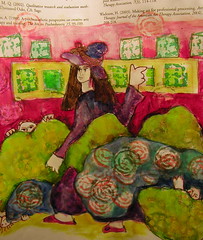« Response art is created when the art therapist, with focused attention, uses his or her sensations, emotions, perceptions, and tacit knowledge of the client to make art. » (Fish 2008, p.70).
Response art serves to investigate a specific question, clarify a feeling, document and explore a mood, expand on felt clinical knowledge. The art is usually (but not always) created post-session. Psychoanalytic minded art therapist call this form of art making: countertransference art. Joanne Kielo a Montreal based art therapist, wrote her thesis on the subject: A study of art therapists’ countertransference and post session imagery (available at Concordia Library). She also published an article on the subject in 1991 (Art Therapy: Journal of the American Art Therapy Association, 8(2), 14-19.)
Response art serves to understand and advance clinical work but also to practice self-care. According to Bruce Moon (1998) it is useful in three ways:
- as an aid in establishing empathic relationships with patients
- as an expressive outlet for the art therapist’s powerful feelings that are often stirred up in the clinical context; and
- as the starting place for imaginative dialogue with patients » (p.22)

In 3) Moon talks about images created by the therapist in session; they are used to communicate with the patient and open up dialogue. Not all art therapists agree on working this way. However at times the visual documentation can make it easier to define what is difficult to describe and help clarify fuzzy feelings.

Yet another use of response art can be found in art therapy supervision. Interns and supervisors can engage in art making, during or after supervision. It is a means of investigating a relationship, case material, exploring identity as therapist, etc. According to B.L. Moon (2002) using art in art therapy supervision is an art therapist’s ethical responsibility (in Fish, p.71). We need a clearer definition of supervision art to claim that its absence is unethical.
This type of art is often quite different, in that it serves to document and define, more than pursue aesthetic criteria. Two of my own examples are included here. They are attempts at clarifying felt impressions. What do you see?
Reference:
Fish, B.J. (2008). Formative evaluation research of art-based supervision in art therapy training. AT:JAATA, 25(2), 70-77.
Classé dans countertransference art, response art, Thérapie.
Catégorisé dans Thérapie.
Publié le 23 fév 2009